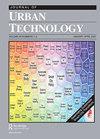屋顶太阳能系统与城市转型:两者会相遇吗?来自印度Rewari的审讯
IF 4.6
3区 经济学
Q1 URBAN STUDIES
引用次数: 1
摘要
印度正面临两大转型。到2040年,印度的能源需求将翻一番,而到2050年,印度将有8亿人居住在城市。本文位于这个十字路口,通过观察位于德里延伸外围的一个地区的太阳能屋顶系统(SRS),为城市能源研究领域做出了贡献。在由村庄和小城镇组成的走廊中使用多管齐下的定性方法,我们认为公共政策的框架是应用刚性的领土网格来反对城市和农村,忽略了住宅和专业用户的动机,这些用户不受农村/城市二元界限的限制。这种脱节解释了可再生能源不会导致对城市和能源系统的新想象。当太阳能的消耗和城市在其周边扩张时,这两个领域仍然是分开的。最后,观察到的多样化城市能源景观(UEL)体现了土地和能源密集型的城市增长形式。本文章由计算机程序翻译,如有差异,请以英文原文为准。
Solar Rooftop Systems and the Urban Transition: Shall the Twain Ever Meet? Interrogations from Rewari, India
ABSTRACT India is facing two major transitions. In 2040, its energy demand will double while 800 million Indians will live in cities by 2050. Situated at this intersection, this article contributes to the field of urban energy research by looking at Solar Rooftop Systems (SRS) in a district located in the extended periphery of Delhi. Using a multi-pronged qualitative methodology in a corridor made of villages and small towns, we argue that public policies are framed applying a rigid territorial grid opposing urban and rural, ignoring the motivations of both residential and professional users, which are not bounded by the rural/urban binary. This disjunction explains that renewable energy does not lead to a new imagination of urban and energy systems. These two fields remain disconnected while solar energy fuels consumption and the city expansion in its peripheries. Finally, the observed variegated urban energy landscapes (UEL) embody a land and energy intensive form of urban growth.
求助全文
通过发布文献求助,成功后即可免费获取论文全文。
去求助
来源期刊

Journal of Urban Technology
URBAN STUDIES-
CiteScore
8.50
自引率
4.20%
发文量
42
期刊介绍:
The Journal of Urban Technology publishes articles that review and analyze developments in urban technologies as well as articles that study the history and the political, economic, environmental, social, esthetic, and ethical effects of those technologies. The goal of the journal is, through education and discussion, to maximize the positive and minimize the adverse effects of technology on cities. The journal"s mission is to open a conversation between specialists and non-specialists (or among practitioners of different specialities) and is designed for both scholars and a general audience whose businesses, occupations, professions, or studies require that they become aware of the effects of new technologies on urban environments.
 求助内容:
求助内容: 应助结果提醒方式:
应助结果提醒方式:


